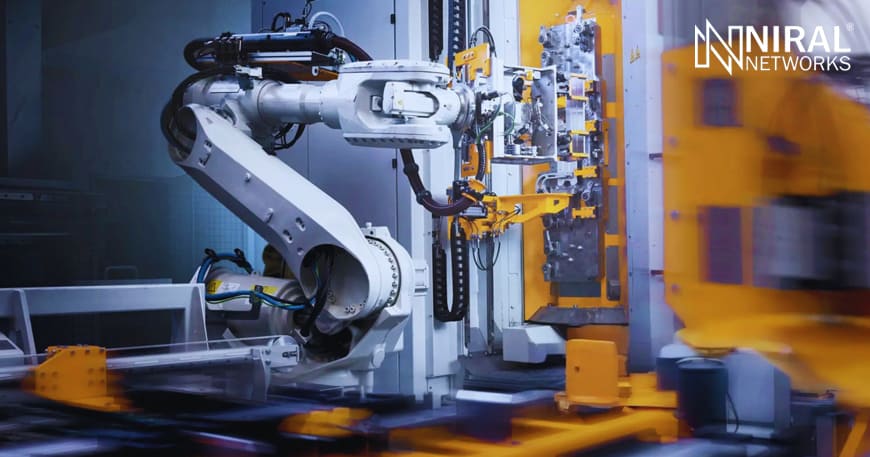Understanding Edge AI: The New Frontier of Industrial Intelligence
Imagine a factory where machines think and act intelligently, making split-second decisions without waiting for distant cloud servers. This is the promise of Edge AI in industrial automation – a revolutionary approach that brings computational intelligence directly to the source of data generation.
What is Edge AI?
At its core, Edge AI is about processing data where it’s created, right at the “edge” of the network. In industrial settings, this means computers and sensors embedded within machinery can analyse information in real-time, without sending every piece of data back to a central cloud server. It’s like giving each machine its own brain, capable of making intelligent decisions instantly.
In the rapidly evolving landscape of industrial technology, Edge AI emerges as a game-changing innovation that’s transforming how manufacturing and industrial processes operate. This blog explores the powerful impact of Edge AI in industrial automation, unveiling how this cutting-edge technology is reshaping the future of manufacturing.
Introduction to Edge AI in Industrial Automation
Edge AI represents a paradigm shift in artificial intelligence applications. Unlike traditional cloud-based AI systems, Edge AI processes data directly at the source – right where it’s generated in industrial environments. This approach means faster processing, real-time decision-making, and reduced dependency on distant cloud infrastructure.
Key differences from traditional AI include
- Immediate data processing at the point of origin
- Reduced latency and network dependency
- Enhanced privacy and security
- Lower bandwidth requirements
- Improved operational responsiveness
Enhancing Manufacturing Processes
The true power of Edge AI shines in manufacturing environments. By enabling real-time data processing and instantaneous decision-making, Edge AI drives unprecedented efficiency across production lines. Imagine machines that can:
- Detect potential issues before they cause disruptions
- Optimize production parameters in milliseconds
- Adjust workflows dynamically based on instantaneous insights
Remarkable case studies demonstrate Edge AI’s transformative potential. For instance, automotive manufacturers have reported up to 30% reduction in downtime and 25% improvement in overall equipment effectiveness by implementing Edge AI solutions.
Optimizing Robotics with Edge AI
Industrial robotics are experiencing a renaissance through Edge AI integration. Modern robotic systems are no longer just programmable machines but intelligent, adaptive workers capable of:
- Autonomous decision-making
- Self-diagnostic capabilities
- Predictive maintenance predictions
- Real-time performance optimization
Consider collaborative robots in electronics manufacturing that can now instantly adjust their movements, detect minor irregularities, and prevent potential errors – all without human intervention.
Smart Plant Automation
Edge AI is revolutionizing plant operations by providing granular, real-time monitoring and control. Key advantages include:
- Instantaneous machinery performance tracking
- Rapid anomaly detection
- Reduced communication latency
- Enhanced operational reliability
- Seamless integration across complex industrial ecosystems
The result? Plants that are more responsive, efficient, and adaptable than ever before.
Predictive Maintenance and Analytics
Perhaps the most compelling application of Edge AI is predictive maintenance. By continuously analysing equipment performance data, Edge AI can:
- Predict potential equipment failures before they occur
- Recommend precise maintenance interventions
- Minimize unexpected downtime
- Optimize maintenance scheduling
- Significantly reduce repair and replacement costs
Companies implementing Edge AI-driven predictive maintenance have reported up to 40% reduction in maintenance costs and 25% decrease in unexpected equipment failures.
Security and Compliance
In an era of increasing cybersecurity concerns, Edge AI offers robust security advantages:
- Localized data processing reduces external exposure
- Enhanced encryption at the data source
- Minimal data transmission reduces vulnerability
- Comprehensive compliance with industry regulations
- Granular access control mechanisms
Implementing best practices like secure hardware, regular software updates, and robust authentication protocols further strengthens Edge AI security frameworks.
Challenges and Solutions
While Edge AI presents immense potential, implementation isn’t without challenges:
- Initial infrastructure investment
- Complex integration with existing systems
- Skills gap in specialized AI expertise
- Data standardization requirements
Successful strategies include
- Phased implementation approaches
- Partnerships with specialized AI solution providers
- Continuous workforce training
- Flexible, scalable architecture design
Looking Ahead: The Future of Industrial Automation
Edge AI represents more than a technological upgrade – it’s a fundamental shift in how industries operate. As manufacturing becomes increasingly complex, the ability to process data instantly and intelligently will separate industry leaders from followers.
Conclusion
Edge AI is transforming industrial automation from a reactive to a proactive, intelligent ecosystem. It’s about creating smart factories where machines don’t just follow instructions, but understand, adapt, and optimize themselves.
For businesses looking to stay competitive in an increasingly digital world, embracing Edge AI isn’t just an option – it’s a necessity.
About Niral Networks
At Niral Networks, we are at the forefront of this technological revolution. Our cutting-edge Edge AI solutions are designed to help industries transform data into actionable intelligence, driving unprecedented operational excellence.
Ready to explore how Edge AI can revolutionize your industrial operations?
Let’s connect and chart your path to the future of smart manufacturing.





